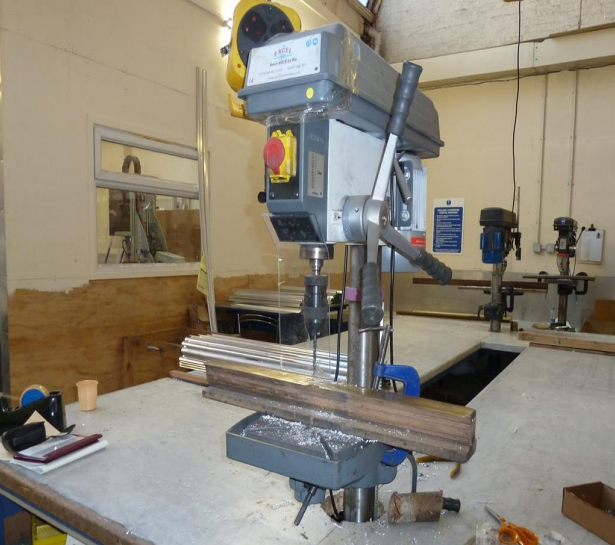Spot The Safety Violation: Avoid These 3 Safety Mistakes
What do you think could happen if a worker wearing gloves used this drill’

Entanglement in machinery is one of the most serious safety hazards workers in many industries may face. If workers’ clothing, hair, jewellery and even PPE gets caught in moving parts of equipment, they could suffer broken bones, amputations or even lose their lives.
This picture from the Health and Safety Executive (HSE), Great Britain’s OHS regulator, shows a factory drill in a manufacturing facility. A worker was using the drill to produce metal sills when the glove on his right hand got caught, pulling his hand around the rotating drill bit. The third finger on his right hand was dislocated and fractured; his little finger was also fractured.
The HSE’s investigation of the incident found that the manufacturer had ignored warnings by its own health and safety officer about how the drill was being used.
Specifically, the guard on the drill was inadequate. It had also become common practice for workers to wear gloves while using the drill’despite the fact that the risk of gloves becoming entangled was well known in the manufacturing industry.
The manufacturer’s health and safety officer had identified inadequate guarding on the drill in a written report over a year before the incident. He’d also raised the issue of workers wearing gloves while using drills. But the manufacturer took no action to address these issues.
AVOID THESE 3 MISTAKES
The manufacturer in England made three key mistakes that you should try to avoid making:
Mistake #1: Ignoring Identified Safety Hazards
The most basic rule of safety compliance and due diligence is that employers must take steps to address safety hazards that have been identified in the workplace. If a hazard is brought to the company’s attention by its safety coordinator, the JHSC, workers or an OHS inspector and the company does nothing to eliminate or minimize the risk posed by this hazard, workers may get injured and the company may get fined.
Here, the manufacturer’s own health and safety officer had raised safety concerns about the use of the drill’but it did nothing in response to these concerns. And as an HSE Inspector said at the manufacturer’s sentencing hearing, ‘There was simply no need for this incident to have happened, especially as Stormguard’s own health and safety officer had raised the issue with the company’There’s absolutely no point in manufacturers hiring health and safety officers if they’re not going to listen to their advice. Risk assessments should be acted on ‘ not put on a shelf to gather dust.’
Mistake #2: Using Inadequate Machine Guards
It’s critical to ensure that any machinery with pinchpoints or other hazards is properly guarded, that is, that the equipment not only has guards but also that those guards adequately protect workers. This manufacturer did have a guard on the factory drill, but that guard didn’t adequately protect workers, as this incident demonstrated.
So if you determine that guards are required on a piece of equipment, install appropriate ones. Proper guards should comply with the requirements under the OHS laws and generally have the following characteristics:
- Actually protect workers from the identified hazards. Machine guards must be adequate, effective and capable of performing their intended function, that is, protecting workers from the hazard from which it’s intended to shield them.
- Comply with any applicable standards. Depending on your OHS law, machine guards may need to comply with voluntary safety standards, such as CSA Standard Z432, Safeguarding of Machinery.
- Don’t create new hazards. A guard shouldn’t endanger workers or create new hazards.
- Don’t interfere with workers’ use of the machinery or equipment. Appropriate guards also shouldn’t interfere with the way workers do their work.
- Are difficult, if not impossible, to remove. An appropriate guard should be designed so that it can’t be removed or can only be removed with tools. (And you should specifically bar anyone from removing machine guards except under designated circumstances.)
- Allow for routine maintenance on the machinery without removal of the guard. If possible, choose a guard that permits repairs, lubrication and other routine maintenance tasks to be done while the guard is still in place.
Adapt and use this Machine Guarding Checklist to ensure that your machine guards meet these requirements.
Mistake #3: Failing to Address Entanglement Risk
As noted above, the manufacturer knew that workers were wearing gloves while using the drill, creating a risk that the PPE would get entangled in the rotating equipment as it did in this case. And the risk of entanglement was common in the manufacturing industry. But the manufacturer didn’t take any steps to prevent entanglements.
For example, it could’ve given its workers these seven tips for avoiding entanglements:
- Wear close-fitting clothing.
- Tuck your shirt into your pants.
- If you must wear a long-sleeved shirt to comply with OHS requirements, button the cuffs. If long sleeves aren’t required, wear short sleeves.
- Don’t wear gloves when working near rotating shafts or other moving machine parts (such as drill bits). If you must wear gloves for safety reasons, make sure they’re suitable for the task.
- Don’t wear jewellery. (Discipline workers who violate your no-jewellery policy.)
- Wear long hair in a bun, tied back or covered with a hat or hairnet.
- Keep facial hair short.